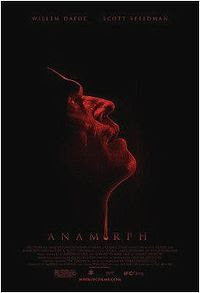Conclusion
This is a gem of a find - an independent film (which means the stars lived in a greasy motel instead of in their own personalised trailers) that stars Willem Dafoe and Scott Speedman (of Underworld fame) in an engaging psychological thriller. Like The Silence of the Lambs, it features a team of special agents taxed and taunted by their perpetrator. Also like The Silence of the Lambs and Manhunter, the focus is on the characters of those doing the hunting instead of on the character of the hunted. But this is not a Robert Harris rip-off. It's more of an Umberto Ecco rip-off.

Plot
The serial killer in this film takes the anamorphosis technique as employed by Julian Beever to an entirely new level. By employing camera obscura, tattoos, finger painting (in a somewhate literal sense) and an elaborate pantograph, he anoints himself as the MacGuyver of the macabre. The blood and guts are almost as vile as agent Stan Aubrey's (Willem Dafoe) fascination with antique chairs.
There are some valuable life lessons to be learnt from the macabre staging of the murders. Of course I shall bore you with them now. You're welcome.
Thinking outside the box
Think outside the box has to be one of the most flogged of dead horses out there. Usually, when life coaches expect this quantum leap of faith from their victims, it results in us unsuspecting victims focusing on boxes. After focusing on boxes, we focus on the inside of the box, then we try to wrap our minds around the box to the outside.
This is usually followed by a blunt sense of irrelevancy to daily commuting, the numbing buzz of fluorescent lights, the flat-line sound of deadlines as they fly by, cafeteria food and the perpetual catharsis resulting from arriving at the water cooler only to find the coffee pot empty, filthy and surrounded by the optical illusion of cattle carcasses complete with hovering vultures and a tumble weed. Thinking about boxes or thinking differently about boxes has somehow failed to deter us lost souls from turning to debauchery for a paradigm shift. Perhaps there is something more fundamentally wrong with our thinking than boxes?
General Semantics and the Death of Some Square Boxes
General semantics is a mental hygiene regimen invented and endorsed by Korzybski. In our usual modes of thinking, logic is based on certain infallible axioms. These axioms are largely derived from Aristotle's laws of thought:
- The law of identity: Also noted as A is A. This means you are what you is.
- The law of non-contradiction: This means A can't be something other than A.
- The law of the excluded middle: This means either A is A, or A is not A. A can't be both A and not A at the same time. Thus, there is no middle way between being A and not being A.
General semantics reminds us that things are not necessarily so three dimensional as we are lead to believe by our dogmatic clinging to Aristotle's legacy. General semantics should not be interpreted as contradicting Aristotle's laws of thought. Instead, they remind us that some things are just unknown, ineffable and inexplicable. As an augmentation to Aristotle, here are the laws of general semantics:
- The law of null-A: Boolean logic, with only true and false categories for all its elements, cannot accurately map the full expressions of our universe. The law of null-A reminds us that some things fall in the murky areas between true and false. Much like Justin Bieber's gender, there are things that are best described in terms of probabilities, instead of with absolutes like A or not A.
- The law of null-I: The law of non-identity reminds us that no two events, no matter how similar, may be considered exactly the same. This actually echoes the law of identity of Aristotle, because it classifies two similar events as two separate events, each with its own identity.
- The law of null-E: The law of non-Euclidean geometry reminds us that Euclidean geometry is insufficient to describe our entire universe. Take a look at hyperbolic geometry and Gödel's (or Godel's) incompleteness theorems.

A hyperbolic triangle. These angles don't add up to 180 degrees.
How does this relate to Anamorph?
Anamorph will remind you that there are many ways to look at a situation. Sometimes, the tools you employ may be the problem. Different tools may give different results. And you don't have to think about boxes.
Director
Henry S. Miller
Cast
Willem Dafoe and Scott Speedman and some other people I don't care to google now.
Rating
Yeah it's aright.


No comments:
Post a Comment